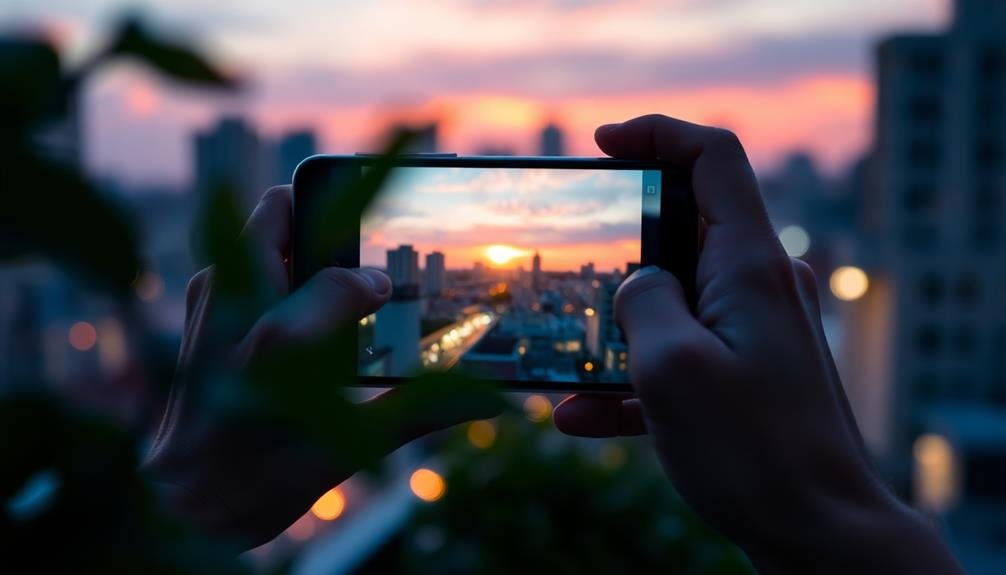Master three key techniques to elevate your smartphone photography and create compelling visual stories. First, apply the Rule of Thirds by placing your subject along grid lines or intersections for balanced compositions. Next, utilize Leading Lines and Framing to guide viewers' eyes and add depth to your images. Finally, capture emotion through perspective by adjusting your angle, distance, and framing to convey power, vulnerability, or intimacy. Enable your phone's grid feature, experiment with natural lines and frames, and play with different viewpoints to enhance your storytelling. Discover how these simple yet powerful methods can transform your mobile photography skills.
Rule of Thirds Mastery

Often overlooked by amateur photographers, the rule of thirds is a fundamental composition technique that can dramatically improve your smartphone photos. This principle divides your frame into a 3×3 grid, creating nine equal sections. The key is to place your main subject along these lines or at their intersections, rather than centering it.
To apply this rule, enable the grid feature in your smartphone's camera settings. As you frame your shot, position important elements along these gridlines. For landscapes, align the horizon with the top or bottom horizontal line. In portraits, place your subject's eyes near the upper intersections.
The rule of thirds creates a more balanced and visually appealing composition. It draws the viewer's eye naturally across the image, creating a sense of movement and interest. You'll find your photos become more dynamic and engaging.
Don't be afraid to break this rule occasionally. Sometimes, symmetry or centrally placed subjects can be powerful.
But mastering the rule of thirds first will help you make informed decisions about when to use it and when to deviate for artistic effect.
Leading Lines and Framing

While the rule of thirds helps organize your composition, leading lines and framing take your smartphone photography to the next level. Leading lines guide the viewer's eye through your image, creating depth and interest. Look for natural lines in your environment: roads, fences, rivers, or even shadows can serve as powerful leading lines. Position these elements to draw attention to your main subject or to create a sense of movement within the frame.
Framing, on the other hand, uses elements within the scene to surround your subject, adding context and depth. You can use doorways, windows, arches, or even tree branches to frame your main subject. This technique not only directs the viewer's focus but also adds layers to your composition.
To effectively use leading lines and framing, experiment with different angles and perspectives. Get low to emphasize a path leading to your subject, or climb higher to capture an overhead view with natural frames.
Don't be afraid to move around and try unconventional viewpoints. Remember, your smartphone's portability is a significant advantage – use it to explore creative compositions that incorporate these powerful techniques.
Capturing Emotion Through Perspective

Three key elements contribute to capturing emotion through perspective in smartphone photography: angle, distance, and framing. By manipulating these factors, you'll create images that evoke powerful feelings in your viewers.
First, experiment with different angles. A low angle can make your subject appear powerful or intimidating, while a high angle might convey vulnerability or smallness. Tilting your phone slightly can add dynamism or unease to the scene.
Next, consider your distance from the subject. Getting close can create intimacy or intensity, allowing viewers to connect with facial expressions or details. Stepping back provides context and can emphasize isolation or scale.
Finally, use framing to direct attention and create mood. Tight framing can heighten emotions by focusing on essential elements, while wider frames can show relationships between subjects and their environment.
Don't forget to pay attention to lighting, which can dramatically affect the emotional tone of your image. Soft, diffused light often conveys calm or melancholy, while harsh contrasts can create tension or drama.
Frequently Asked Questions
How Do I Capture Great Low-Light Photos With My Smartphone?
To capture great low-light photos with your smartphone, you'll need to steady your device, use night mode if available, tap to focus, and avoid flash. Experiment with manual settings, like ISO and shutter speed, for better control.
What Are the Best Smartphone Apps for Advanced Photo Editing?
You'll find several excellent apps for advanced photo editing. Try Snapseed, VSCO, or Lightroom Mobile for powerful tools. They offer precise adjustments, filters, and advanced features like selective editing and RAW processing. Experiment to find your favorite.
How Can I Effectively Use HDR Mode on My Smartphone Camera?
To use HDR effectively, you'll want to enable it for high-contrast scenes. Hold your phone steady, frame your shot, and capture. HDR combines multiple exposures, so it's great for landscapes and backlit subjects. Avoid moving objects.
What Smartphone Accessories Can Enhance My Mobile Photography Skills?
You'll boost your mobile photography with these accessories: a tripod for stability, clip-on lenses for versatility, a portable light for better illumination, and a bluetooth remote shutter. Don't forget a power bank to keep shooting longer.
How Do I Achieve a Professional-Looking Bokeh Effect With My Smartphone Camera?
To create professional-looking bokeh on your smartphone, you'll want to get close to your subject, maximize the distance between subject and background, use portrait mode if available, and experiment with manual focus and aperture settings.
In Summary
You've now got the tools to elevate your smartphone photography. Remember, the rule of thirds will guide your composition, leading lines will draw viewers in, and changing your perspective can capture raw emotion. Don't be afraid to experiment with these techniques. Practice them often, and you'll soon find yourself creating more compelling visual stories. Your smartphone's potential is limitless – it's up to you to access it and share your unique vision with the world.





Leave a Reply